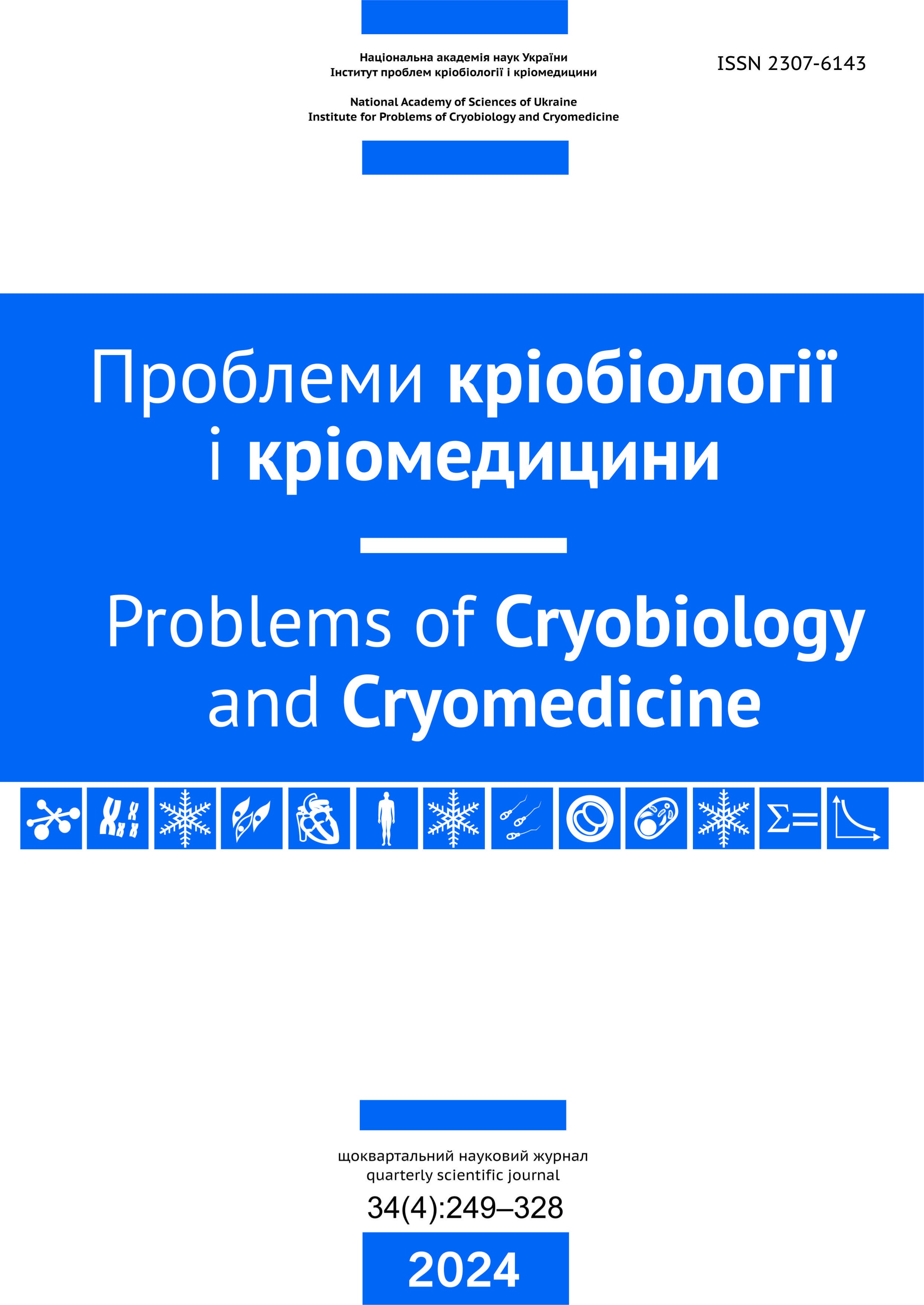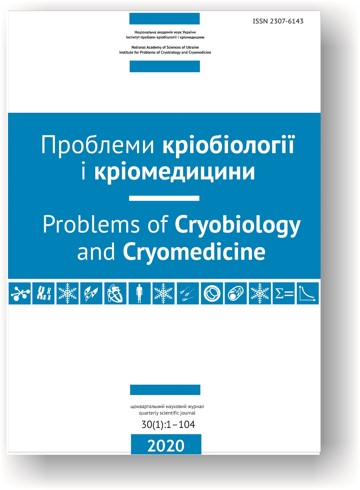Pilot Study of Hibernation Patterns in Noctule Bats (Nyctalus noctula): Influence of Group Size
DOI:
https://doi.org/10.15407/cryo34.04.251Keywords:
torpid state, thermoregulation, arousal dynamics, energy conservation, clustering effect, temperature cyclesAbstract
This study investigated the influence of group size on the hibernation patterns of adult males of Nyctalus noctula during hibernation. Bats were divided into three categories (solitary, groups of six, and groups of sixteen) and nine experimental groups comprising one individual with temperature logger per group (iButton). Skin temperature (Ts) was monitored every five minutes. The results showed that bats in larger groups (the group of sixteen) entered longer and more stable torpor, with no instances of full arousal (Ts >20°C). In contrast, solitary bats exhibited more frequent arousals. All bats entered deep torpor after the first nine days. No significant differences in body mass loss were found between the groups. The findings highlight the importance of group size in reducing arousals during hibernation, and the role of social thermoregulation in conserving energy.
Probl Cryobiol Cryomed 2024; 34(4):251–260
References
Arlettaz R, Ruchet C, Aeschimann J, et al. Physiological traits affecting the distribution and wintering strategy of the bat Tadaridateniotis. Ecology. 2000; 81: 1004-14. CrossRef
Blažek J, Zukal J, Bandouchova H, et al. Numerous cold arousals and rare arousal cascades as a hibernation strategy in European Myotis bats. J Therm Biol. 2019; 82: 150-6. CrossRef PubMed
Boratyński JS, Willis CKR, Jefimow M, et al. Huddling reduces evaporative water loss in torpid Natterer's bats, Myotis nattereri. Comp Biochem Physiol A Mol Integr Physiol. 2015; 179: 125-32. CrossRef PubMed
Boyles JG, Johnson JS, Blomberg A, et al. Optimal hibernation theory. Mammal Rev. 2020; 50: 91-100. CrossRef
Boyles JG, Storm J, Brack V. Thermal benefits of clustering during hibernation: A field test of competing hypotheses on Myotis sodalis. Funct Ecol. 2008; 22(4): 632-6. CrossRef
Kravchenko K. Migratory bats and global climate change: climate-driven changes in migratory behaviour and distribution of the common noctule bat (Nyctalus noctula). Ph.D. Thesis, Department of Biology, Chemistry, Pharmacy, Freie Universität Berlin, Berlin, Germany; 2021. 114 p. [Internet]. 2021 Jan 04 [cited 2024 Dec 19]. Available from: https://refubium.fu-berlin.de/handle/fub188/32716 CrossRef
Kravchenko KA, Vlaschenko AS, Lehnert LS, et al. Generational shift in the migratory common noctule bat: first-year males lead the way to hibernacula at higher latitudes. Biol Lett. [Internet]. 2020 Sep 23 [cited 2024 Nov 15]; 16: 20200351. Available from: https://royalsocietypublishing.org/doi/epdf/10.1098/rsbl.2020.0351 CrossRef PubMed
Kravchenko KA, Vlaschenko AS, Lehnert LS, et al. Year-round monitoring of bat records in an urban area: Kharkiv (NE Ukraine), 2013, as a case study. Turk J Zool. 2017; 41: 530-48. CrossRef
Lindecke O, Currie SE, Fasel NJ, et al. Common Noctule Nyctalus noctula (Schreber, 1774). In: Hackländer K, Zachos FE, editors. Handbook of the Mammals of Europe. Cham: Springer; 2023. pp 463-87. CrossRef
Moiseienko M, Vlaschenko AS. Deep torpor patterns and body mass loss of above-ground hibernating bats (Nyctalus noctula) in captivity; effects of sex, age and grouping. Act Chir. 2023; 25(2): 299-310. CrossRef
Prylutska A, Yerofeieva M, Bohodist V, et al. The dataset of bat (Mammalia, Chiroptera) occurrences in Ukraine collected by the Ukrainian Bat Rehabilitation Center (2011-2022). Biodiver Data J. [Internet]. 2023 Mar 7 [cited 2024 Nov 15]; 2023; 11: e99243. Available from: https://bdj.pensoft.net/article/99243 CrossRef PubMed
Ruf T, Geiser F. Daily torpor and hibernation in birds and mammals. Biol Rev. 2015; 90: 891-926. CrossRef PubMed
Sachanowicz K, Wower A. Borowce wielkie nabalkonach katowickiego wysokościowca. Przyroda Górnego Śląska. 2009; 58: 6-7. Polish.
Speakman JR, Thomas DW. Physiological ecology and energetics of bats. In: Kunz TH, Fenton MB, editors. Bat ecology. Chicago, IL: University of Chicago Press; 2003. p. 430-90.
Turyanin II. [Some peculiarities of bat behaviour in aggregations. In: Mammalian behaviour. Theoretical issues]. Moscow: Nauka; 1977. p. 244-6. Russian.
Vlaschenko A, Kravchenko K, Yatsiuk Y, et al. Bat assemblages are shaped by land cover types and forest age: a case study from Eastern Ukraine. Forests. [Internet]. 2022 Oct 20 [cited 2024 Nov 20]; 13(10): 1732. Available from: https://www.mdpi.com/1999-4907/13/10/1732 CrossRef
Vlaschenko AS, Kovalov VV, Hukov VS, et al. An example of ecological traps for bats in the urban environment. Europ J of Wild life Res, 2019; 65: 1-5. CrossRef
Downloads
Published
How to Cite
Issue
Section
License

This work is licensed under a Creative Commons Attribution 4.0 International License.
Authors who publish with this journal agree to the following terms:
- Authors retain copyright and grant the journal right of first publication with the work simultaneously licensed under a Creative Commons Attribution License that allows others to share the work with an acknowledgement of the work's authorship and initial publication in this journal.
- Authors are able to enter into separate, additional contractual arrangements for the non-exclusive distribution of the journal's published version of the work (e.g., post it to an institutional repository or publish it in a book), with an acknowledgement of its initial publication in this journal.
- Authors are permitted and encouraged to post their work online (e.g., in institutional repositories or on their website) prior to and during the submission process, as it can lead to productive exchanges, as well as earlier and greater citation of published work (See The Effect of Open Access).




